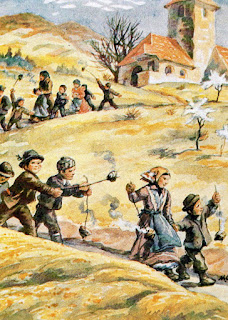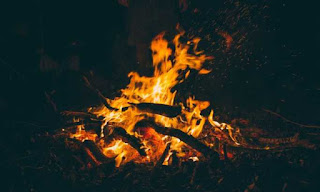There is an interesting Easter Friday custom in Slovenia called "strašenje Boga" (scaring God). It involves people piling up old wooden objects in front of the church, and beating them with poles making as much noise as possible, until the objects are broken to bits...
The wood was then used on Easter Saturday morning for lighting the sacred Need fire. In some parts of Slovenia, every house would bring their own log which was placed in the pile. In Carinthia, the priest collected old, removed wooden crosses and wreaths from graves and carried them in a pile.
The once all the wood was piled up, fire was kindled using iron and flint. The priest would then bless the fire and this, now sacred new fire, was used to light up the new fire in all the village house hearths.
The house hearth fire was considered sacred in Slovenia and was always kept burning by the housewife. In the evening it was not extinguished. In the evening, the housewife covered the embers with ashes, and in the morning she blew into the embers and started the fire again. The only time the fire was extinguished was on Good Friday, when the hearth was cleaned and prepared for the arrival of the new fire which was brought from the sacred blessed fire lit up in front of the church...
Now the fire was brought from the church to each house by one of the boys from the house using tinder fungus.
It is so called because in the past people used it to "cary fire" from one place to the other. Once lit, it will not burn but smoulder for a long time allowing fire to be preserved and transported over long distances...
As soon as the fire was blessed, boys would rush towards the fire with a tinder fungus stuck on a long stick. They all wanted to be the first to catch the fire and the first to bring it to their house...The kids had to be careful not to let the fire be extinguished nor to let it flare up, as either would prevent them from actually reaching the house with a fire still burning in the fungus. If any burning bit fell off the fungus, it had to be thrown into a green wheat or barley field.
Once the boys reached their houses, they had to give the burning tinder to their mothers, so that they can start the new yearly house fire.
Last year's Palm Sunday spring greenery bundle called "butarica" was ceremonially placed on the new fire and burned. Pic: people bringing "butarice" to the church to be blessed...
It was believed that starting a house fire with the blessed fire from the communal bonfire would protect the house from fire...
After their house fire was rekindled, the boys would run through the village announcing this to everyone else...
Not all of the tinder fungus was used for lighting the house fire. A piece of burning tinder fungus had to be thrown into every field and meadow so it will be blessed too and would yield well that year. This ceremony was also performed by children...
This is very very interesting.
Ethnographer dr. Niko Kuret says that "The blessing of the fire ceremony was probably the remnant of some pagan spring ritual dedicated to fire"...
Ha!
I wonder what ceremony could that be? Does this has anything to do with Jarilo, Slavic young sun god, whose name means "The Brightly Burning one"?
Is the new sacred fire, lit on Easter Saturday, symbolic representation of Jarilo's fire, young sun's fire?
I think so...
It is Jarilo's return from "the Otherworld" (winter) which brings spring and makes the land green again. Jarilo's name also means "The Green one". It is his brightly burning "sacred fire" that melts the snow, ends infertile white winter and starts fertile green spring...
I think that this is why the bits of sacred fire are thrown into fields. Fields are symbolically blessed, by Jarilo, The Brightly Burning One, The Young Sun god, who is represented by the "sacred bonfire"...
Finally two questions:
Which god is being frightened by banging wood in front of the church? Jarilo? Or...?
And why are crosses burned in the so obviously pagan sacred fire ceremony?
Illustrations: Maxim Gaspari. Text describing the ceremony from "Blessed fire from the tinder fungus" and "Easter customs in Slovenia"
PS: This is of course just one of many similar fire rituals performed at the end of winter beginning of spring or at the beginning of summer throughout Europe...All basically celebrating the return of the sun and the rebirth of nature...








A fascinating read. I am interested to hear your opinion on the ("young"?) god Svarozhich (Сварожић)- diminutive form of Svarog and perhaps his son, which was seemingly the god of fire, heat, hearth, and war. I know that Svarozic was especially popular amongst the Polabian Slavs, but that can place it close to the Carantanian Slavs? Could this ritual be a remnant of Svarozic worship? Just a thought.
ReplyDeleteI think that this was just another name of the same Deity...Young sun god...Slavs saw sun's fire and hearth fire as one and the same...We can see that from our "Christmas" fire rituals which are connected with the rekindling of the sun's fire...This is the same in many other cultures...Slavs are not an exception...
Delete